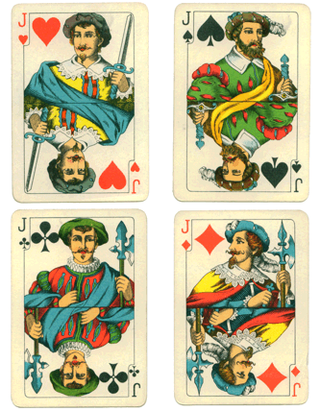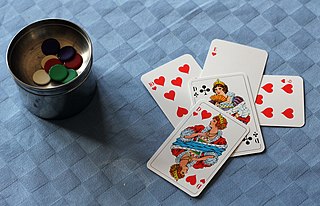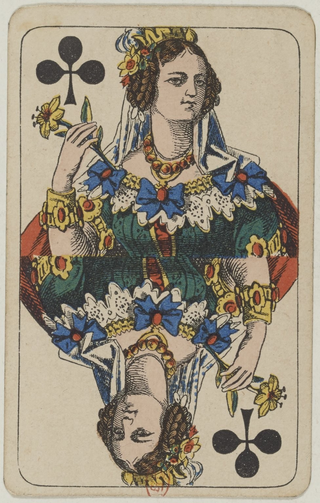
Oh hell or contract whist is a trick-taking card game of British origin in which the object is to take exactly the number of tricks bid. It was first described by B. C. Westall around 1930 and originally called oh! well. It was said to have been introduced into America via the New York clubs in 1931. Phillips and Westall describe it as "one of the best round games."

Whist is a classic English trick-taking card game which was widely played in the 18th and 19th centuries. Although the rules are simple, there is scope for strategic play.

Skat, historically Scat, is a three-player trick-taking card game of the ace–ten family, devised around 1810 in Altenburg in the Duchy of Saxe-Gotha-Altenburg. It is the national game of Germany and, along with Doppelkopf, it is the most popular card game in Germany and Silesia and one of the most popular in the rest of Poland. A variant of 19th-century Skat was once popular in the US. John McLeod considers it one of the best and most interesting card games for three players, and Kelbet described it as "the king of German card games." The German Skat Association assess that it is played by around 25 million Germans – more than play football.

Bid whist is a partnership trick-taking variant of the classic card game whist. As indicated by the name, bid whist adds a bidding element to the game that is not present in classic whist. Bid whist, along with spades, remains popular particularly in U.S. military culture and a tradition in African-American culture.

Preferans or Russian Preference is a 10-card plain-trick game with bidding, played by three or four players with a 32-card Piquet deck. It is a sophisticated variant of the Austrian game Préférence, which in turn descends from Spanish Ombre and French Boston. It is renowned in the card game world for its many complicated rules and insistence on strategical approaches.
German whist is a variant of classic whist for two players in which the reward for winning the first 12 tricks is to add a particular card to your hand. Also called Chinese whist, it is probably of British origin.

Polskpas, Polsk Pas, or Polskt Pass is a Scandinavian 5-card plain-trick game for four individual players using 24 cards. Eldest hand has the first right to accept or make trumps. As is typical for Schafkopf card games, which are normally point-trick games, the four Jacks are known as Wenzels and form permanent highest trumps. Polskpas is similar to the historical German game of Kontraspiel.
Mizerka is a trick-taking card game belonging to the Whist group. Mizerka is a three-person game. Although it originates in Poland, Mizerka's popularity has largely increased in the United States. What distinguishes Mizerka from tradition trick is the use of a fourth dealt pile, serving as a talon with which players can exchange their cards.

Tapp Tarock, also called Viennese Tappen, Tappen or Tapper, is a three-player tarot card game which traditionally uses the 54-card Industrie und Glück deck. Before the Anschluss (1938), it was the preferred card game of Viennese coffee houses, for example, the Literatencafés and Café Central. Even today Tapp Tarock is played sporadically. The exact date when it appeared is not possible to identify; some sources suggest it may have been developed in Austria in the early 19th century, but its mention in caricature operas in 1800 and 1806 suggest it was well known even by then and must have arisen in the late 18th century. The oldest description of the actual rules is dated to 1821. Tapp Tarock is considered a good entry level game before players attempt more complex Tarock forms like Cego, Illustrated Tarock or Königrufen.

Bräus is an old Swedish card game from the island of Gotland that differs from all others in that not all cards are actually playable. The game is descended from the oldest known card game in Europe, Karnöffel, a fact testified by its unusual card ranking and lack of a uniform trump suit.

Norseman's knock or Norrlandsknack is a classic Swedish card game for 3 to 5 players, known since the mid-1800s. It is traditionally played for money. The game is about winning as many tricks as possible and above all not being completely left without a trick.
Trekort, Tre-Kort or, in Swedish, also Trikort, is an old card game of Danish origin for four or five players that was usually played for money. It was also known in Sweden, where it developed into the variant of Knack. The name Trekort is also loosely used to describe related three-card games such as Swedish Köpknack. The name means "three cards" and may therefore be related to German Dreiblatt.

Köpknack is an old Swedish card game which is a development of Knack and, like the latter, is mainly played for stakes. The game is also known as Trekort which, however, usually refers to a simpler version of Danish origin that may have been its progenitor.

Femkort is a classic Swedish card game for 3 to 8 players "with an unusual object", known since the 17th century, being mentioned in 1658 in Georg Stiernhielm's epic poem, Hercules (Herkules) as Fämkort. It is traditionally played with some kind of bet.

Knektpass or Knekt-Pass, also called Rams, is an old Swedish card game of the Rams group, mentioned as early as 1834. It is a trick-taking game for two or more players and features the four Jacks as top trumps.

Rödskägg ("Redbeard") also called Fem Opp, is a Swedish card game for three to seven players in which penalties are incurred for failing to follow certain rituals as well as for failing to take a declared number of tricks. Some rules describe Fem Opp as a variant of Rödskägg. It is an advanced and tactically demanding game and, of games played in Sweden, only Bridge and Poker are considered more difficult.

Skærvindsel is a Danish card game for four players that is a member of the Schafkopf family. Today it is mostly played in Jutland and is therefore often spelled Sjervinsel, but was previously widespread throughout Denmark. It was the first Danish game where the winner of the auction, the declarer, could choose a partner by calling an Ace. This principle has since been transferred to Call-Ace Whist (Esmakkerwhist).
Call-ace whist or Danish whist is a card game for four players playing in variable partnerships. It is the most popular form of Whist in Denmark, where it is often just called "Whist". It has a well developed bidding system and has imported from the traditional Danish game of Skærvindsel the feature of determining the partnerships by 'calling an ace'. John McLeod records that there is also a version of Danish whist in which there are fixed partnerships.

Sjavs is a Danish card game of the Schafkopf family that is played in two main variants. In Denmark, it is a 3-player game, played with a shortened pack of 20 cards; in the Faroe Islands, where it is very popular, it is a four-hand, partnership game using a standard piquet pack of 32 cards.

Priffe or Preference is a classic Swedish, trick-taking card game for four players who form two teams of two. It is an elaboration of Whist that involves bidding, but this is a different form from that in American Bid Whist. Together with Vira, Priffe was one of the most common card games in Sweden until superseded by Bridge.













